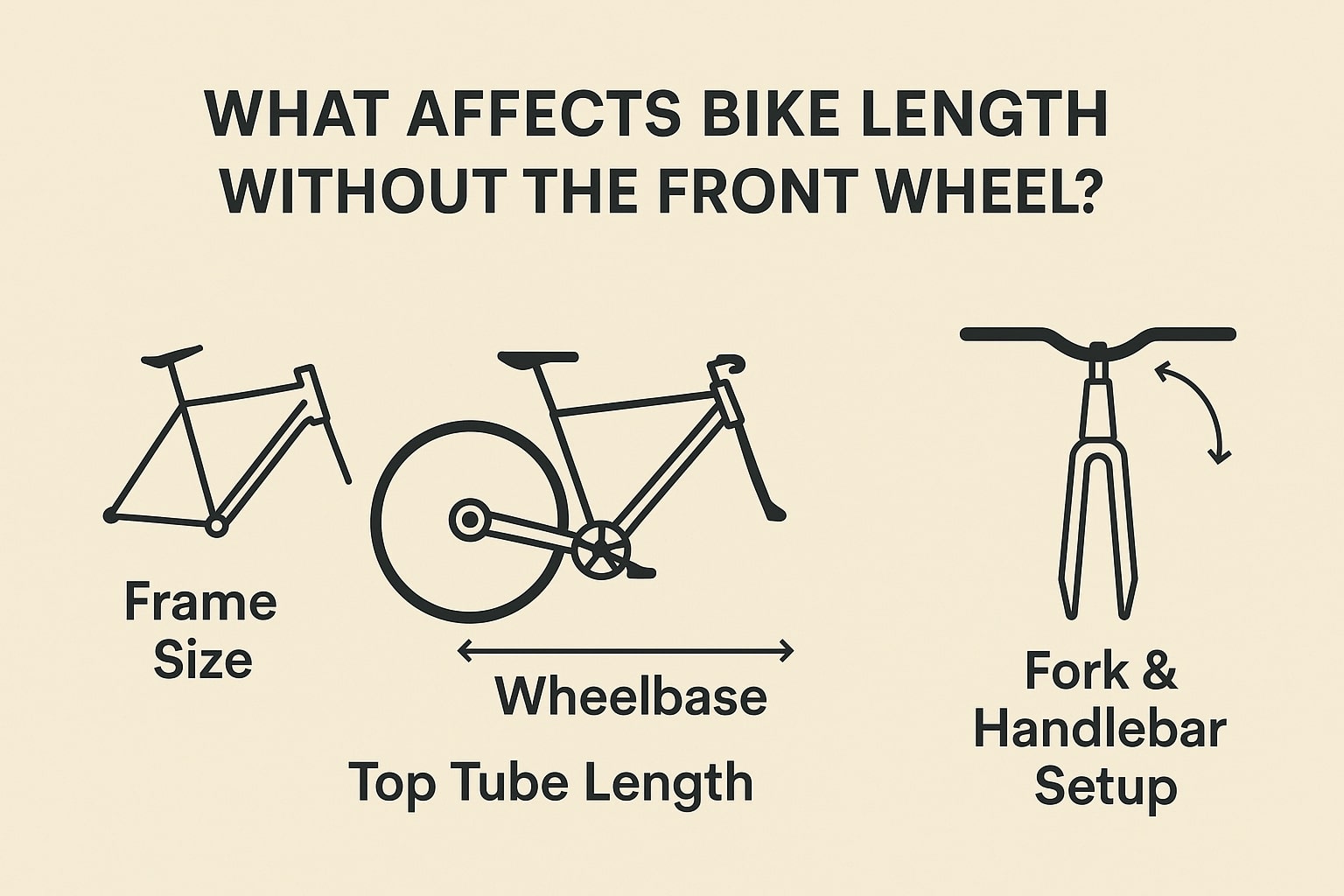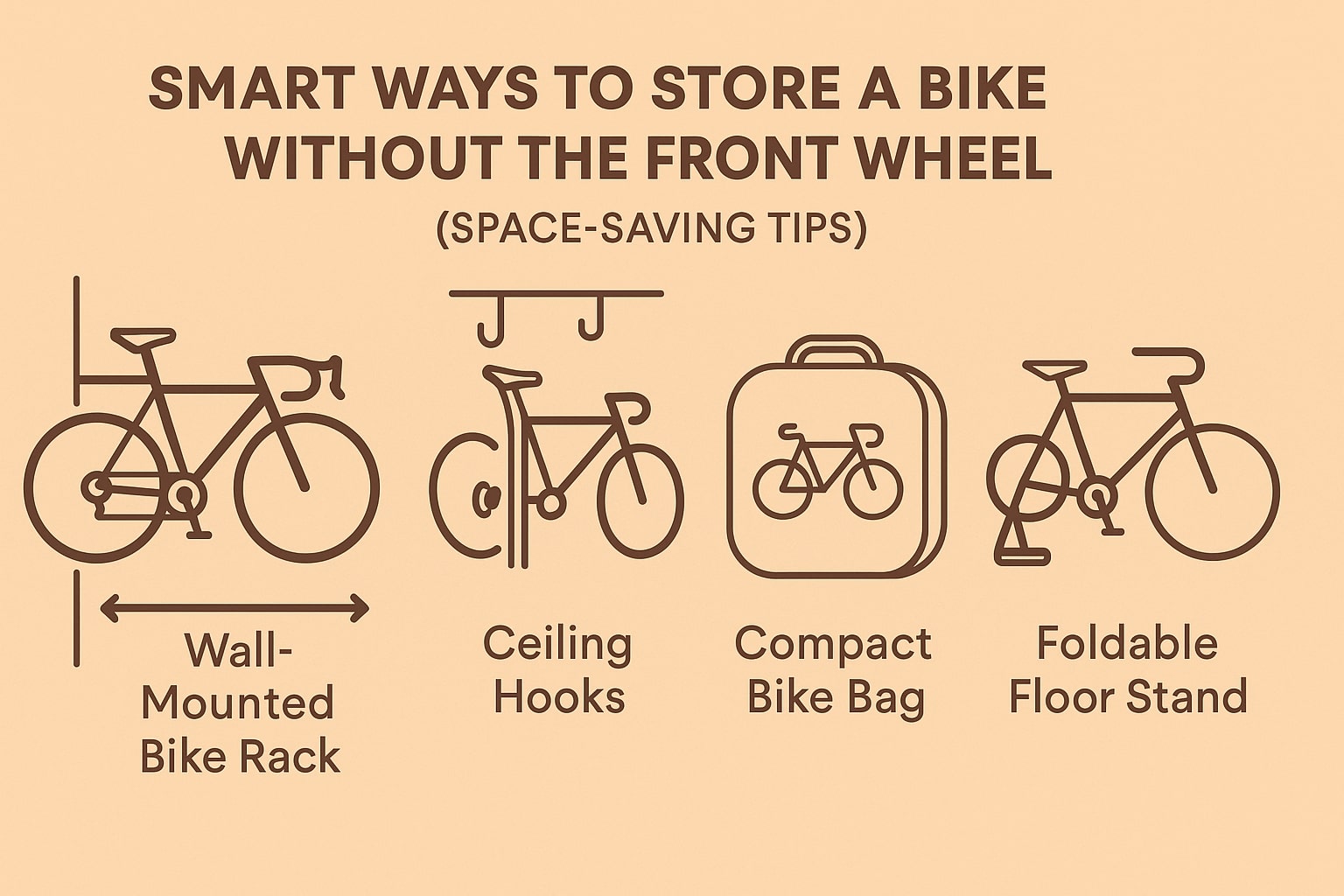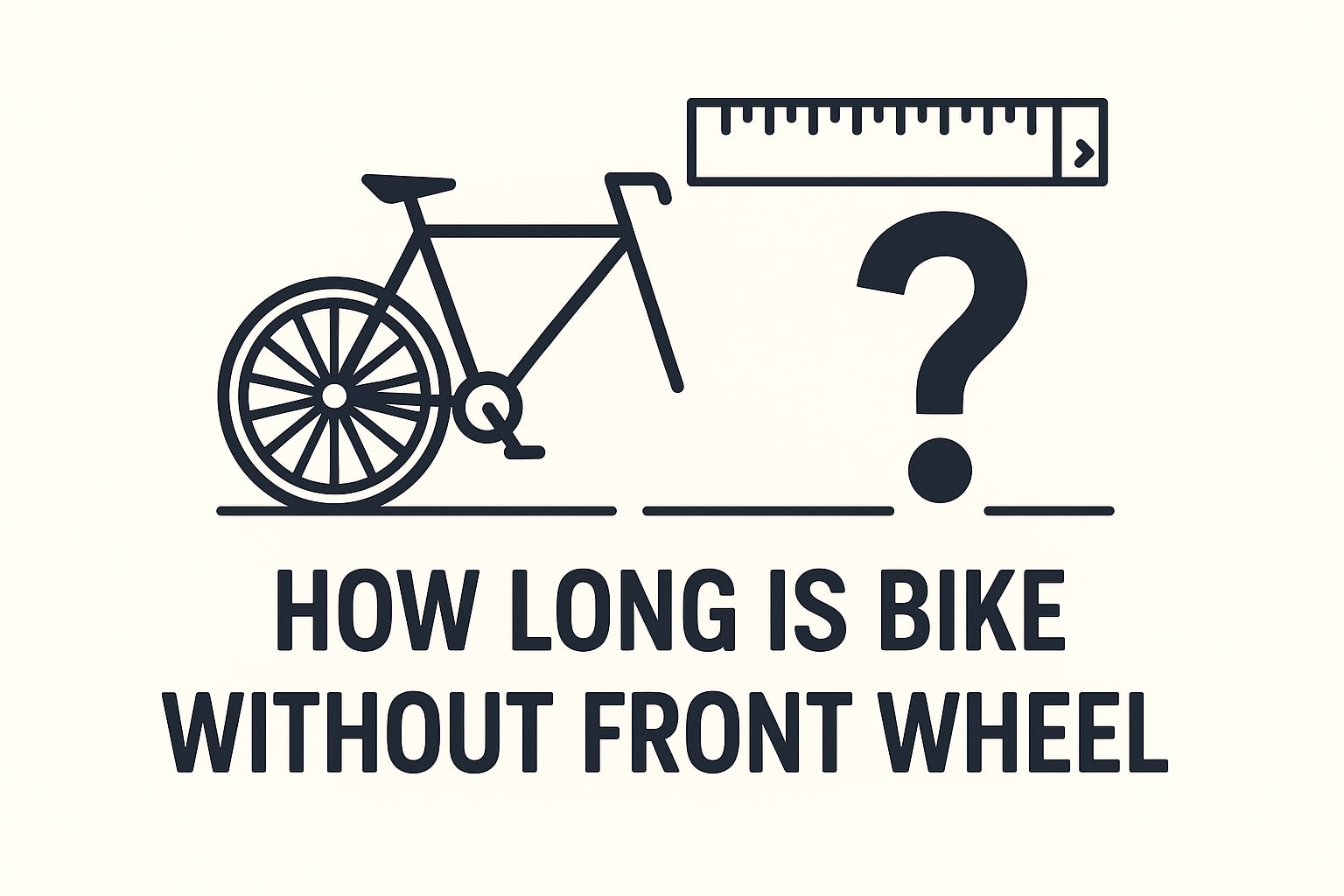Ever wondered how long is bike without front wheel, especially when you’re trying to fit it into your car, pack it for a flight, or store it in a tight corner?
It’s not just a number.
It’s one of those small details that make transport and storage a whole lot easier.
Whether you’re a casual rider or a serious cyclist, knowing your bike’s dimensions without the front wheel can save you time, effort — and even damage.
In this guide, I’ll walk you through average lengths by bike type, how to measure your own setup, and share simple tips to move and store your bike smarter — not harder.
Why Knowing How Long Your Bike Is Without the Front Wheel Actually Matters
Knowing your bike’s size is good — but understanding how long is bike without front wheel is where things get real.
That’s where things get practical.
Let’s say you’re loading your bike into a hatchback, storing it in an apartment, or shipping it in a box — having the right measurement can be the difference between a perfect fit or a total headache.
It’s also helpful to know how long your bike is without the front wheel when comparing frame sizes or buying online.
Dimensions tell you how much space the bike actually takes up, how it handles, and whether it’ll work for your setup — especially once the front wheel is off.
Why Accurate Bike Measurements (Without Front Wheel) Matter
Getting accurate measurements isn’t just about fit — it’s about comfort, safety, and performance.
If your bike is too long or too short (especially without the front wheel), you’ll struggle with handling, posture, and constant adjustments.
A few inches off can mean knee pain, back strain, or even poor control on the road.
That’s why knowing the right dimensions before transport or purchase saves you from regrets later.
Whether you’re packing your bike, storing it, or buying a new frame, accurate measurements keep things smooth and stress-free.
How Long Is a Bike Without the Front Wheel? (By Type)
Bicycles vary in size and type, each suited for different rides.
I look at sizes like road bikes, mountain bikes, and hybrids.
Each bike type affects how long is bike without front wheel — and how it handles during transport.
For example, road bikes are long for speed, while mountain bikes are short for agility.
Knowing these sizes helps me choose the right bike, making my rides more enjoyable.
how long is a bike without the front wheel?
It depends on the type.
Road bikes tend to run longer for speed and aerodynamics, while mountain bikes are built shorter for control and off-road agility.
Folding bikes? Super compact — made for tight storage spaces and easy travel.
Here’s a quick breakdown of how long bikes are without front wheels, based on type.
| Bike Type | Length Without Front Wheel |
|---|---|
| Road Bike | 67 – 72 inches |
| Mountain Bike | 65 – 70 inches |
| Folding Bike | 50 – 60 inches |
| Hybrid/Commuter | 66 – 71 inches |
These are average numbers, but your actual bike length without front wheel may vary.
Your exact measurement can vary based on frame size, geometry, and design — especially if you ride a custom build.
Whether you’re trying to fit your bike into a car, box it for shipping, or hang it in your hallway, knowing how long your bike is without the front wheel makes all the difference.
What Affects Bike Length Without the Front Wheel?

When the front wheel is off, your bike might look shorter — but how much shorter depends on a few key factors.
Let’s break it down.
1. Frame Size
Bigger frame, longer bike. Simple as that. A 56cm frame will obviously take up more length than a 48cm one. How long your bike is without the front wheel mostly depends on your frame size.
2. Wheelbase
This is the distance between the front and rear axles. Bikes with longer wheelbases — like endurance road bikes or gravel bikes — will still be fairly long even with the front wheel removed.
3. Top Tube Length
A longer top tube can extend the front end of the frame, especially in road and race bikes. Even without the wheel, that added length remains — and can affect how well the bike fits into your storage or transport setup.
4. Fork Angle and Design
Some forks are more raked forward than others. The angle and shape of your fork can influence how far forward the frame stretches without the front wheel.
5. Handlebar Setup
If you don’t remove or rotate your handlebars, they might stick out and increase the length — especially flat bars on hybrids or mountain bikes.
So when someone asks “what affects bike length without the front wheel,” the answer isn’t just the frame — it’s the entire geometry and setup.
That’s why measuring how long is bike without front wheel is smarter than guessing.
How to Measure a Bike Without the Front Wheel (Step-by-Step with Tools)

Whether you’re packing your bike into the back of a hatchback or checking it in for a flight, knowing the exact length of your bike without the front wheel can save you serious time and frustration.
Guesswork = stress.
Accurate measurements = smooth ride.
Tools You’ll Actually Need:
-
Measuring tape (soft, at least 80 inches, tailor-style preferred)
-
Flat surface like your garage or driveway
-
Bike stand (if available — makes the job much easier)
-
Notebook or phone (to save measurements)
-
Optional: Digital caliper (if you want to be super precise with bar width, fork spacing, etc.)
Step-by-Step Guide:
1. Prep Your Bike
Remove the front wheel and make sure your bike is stable.
If you have a stand — use it.
If not, lean the bike carefully against a wall with the pedals and handlebars balanced.
Make sure it’s not leaning too much, or your measurements will be off.
2. Measure from Rear Axle to Fork Crown
To measure how long is bike without front wheel, start your tape at the rear axle.
Pull the tape straight to the center of the fork crown (where the front wheel was mounted).
This gives you the core bike length without the front wheel.
Pro Tip: Don’t measure along the top tube — that’s not the true frame length for transport.
3. Measure Handlebar Width (Optional but Useful)
Turn your handlebars to align with the frame.
Then measure from one end of the handlebar grip to the other.
Wide MTB bars often make it harder to store the bike even if the frame is short.
4. Measure Vertical Height (Optional)
If you’re placing your bike in a tight vertical space (like a car trunk), also measure from ground to the top of the seat post.
Helps avoid last-minute surprises.
5. Record Everything Clearly
Write your measurements down. I usually log:
-
Frame length (rear axle to fork)
-
Bar width
-
Vertical height
You’ll thank yourself for knowing how long is bike without front wheel next time you’re packing in a rush.
Real-Life Use Case
Last time I had to load my hybrid bike into a hatchback, I didn’t double-check the bar width.
Took the wheel off — and still didn’t fit!
One quick measurement could’ve saved 20 minutes of rearranging luggage and removing the seat.
Standard Bike Length Without Front and Rear Wheels: What to Expect
Ever wondered how long is bike without front wheel and rear wheel when it’s fully disassembled?
Understanding the standard bike length without wheels helps a lot — especially when you’re storing your bike in a car trunk, a tight hallway, or packing it for shipping.
Even when the wheels are off, how long the bike is without the front wheel still depends on the type.
Let’s break it down.
-
Road bikes (wheel-free): Around 39–42 inches (main frame only)
-
Mountain bikes: Roughly 36–41 inches, depending on suspension and frame design
-
Folding bikes: Even more compact, usually 30–35 inches
But remember — these are frame-only measurements.
If the handlebars are still on or the seat post is extended, it’ll be longer.
You might still need to rotate or remove parts for a better fit.
If you ride a custom bike, measurements may differ slightly. That’s why it’s smart to measure your own setup before planning for transport or storage.
smart Ways to Store a Bike Without the Front Wheel (Space-Saving Tips)

Removing the front wheel definitely saves space — but only if you know how to store the bike smartly.
Whether you’re dealing with a tight garage, a small apartment, or packing for travel, here are some practical ways to store your bike without the front wheel.
1. Wall-Mounted Bike Racks
This is a favorite for many riders. Wall racks let you hang the bike by its frame or rear wheel, saving floor space.
Just make sure the rack can handle the weight with the wheel removed, and the handlebars won’t bump the wall.
2. Ceiling Hooks
Ideal for very tight spaces or shared rooms.
You can hang your bike vertically by the rear wheel.
Some riders prefer this setup in storage sheds or basements.
3. Compact Bike Bags
Perfect for travel or indoor storage.
These bags are padded, zippered, and often designed to hold both the frame and detached wheels.
Great for protecting your bike from dust and scratches.
4. Foldable Floor Stands
If you prefer to keep your bike on the ground, foldable stands hold the frame upright even without the front wheel.
Super helpful for people who move their bikes frequently.
Pro Tip:
If your handlebars stick out too much, turn them sideways or loosen and rotate them inward. It instantly reduces the bike’s profile and helps with compact storage.
Related: How to measure Bike Frame
How to Transport a Bike Without Wheels (Backed by Real Experience)
Transporting a bike is easy — once you know how long is bike without front wheel.
— until you realize parts can get scratched, bent, or worse… lost.
I’ve had to move my bike dozens of times — by car, by train, and once even on a domestic flight.
Over the years, I’ve figured out what works (and what doesn’t) when it comes to transporting a bike without the front wheel.
1. Always Remove the Front Wheel Carefully
Use a proper quick-release lever or wrench. Once the wheel is off, never let the fork drop to the ground — place a fork block or some padding to keep it safe.
2. Use Padding to Protect the Frame
When I know how long my bike is without the front wheel, I pack it with bubble wrap, especially around the fork and stays.
You don’t need fancy gear — just smart protection that cushions impact during movement.
3. Choose the Right Bike Bag or Box
If you’re flying, go for a hard case. For car transport, a padded soft bag works fine. I’ve used both, and trust me — the peace of mind is worth it.
4. Don’t Forget Small Parts
Store bolts, skewers, and pedals in a labeled zip bag and tape it to the frame or drop it into the bike bag pocket. You don’t want to be hunting for missing pieces when reassembling.
5. Common Mistake to Avoid
Don’t just toss the frame into your car trunk unpadded — it might fit, but even one hard brake can cause damage. Secure it properly using straps or by wedging it in with soft items like clothes or blankets.
Real-World Tip:
When I flew with my bike for the first time, I didn’t pad the chainring. It got slightly bent during loading. Now, I always place cardboard or foam between the crank and outer case. A 2-minute fix that saves a big repair.
Disassembled Bike Measurements: Measure the Full Breakdown Like a Pro
When you’ve taken off both wheels — or even more parts — your bike becomes much easier to store or ship.
But to make it actually fit in the space you’re aiming for, you need accurate measurements of the disassembled frame.
This is something I’ve had to do several times — whether packing for a move or storing my bike during the off-season.
Here’s exactly how to measure your fully or partially disassembled bike.
1. Start with the Frame
Lay the frame flat on the ground or stand it upright if stable.
Now measure:
-
From the rear axle to the fork crown
-
From the bottom bracket to the top tube or seat post (vertical height)
-
Note the angle of the frame if it’s non-standard geometry (gravel, endurance bikes)
2. Handlebar Width
Flat bars or wide drop bars can take up more space than expected. If you haven’t removed them, measure end-to-end grip width.
Pro Tip: Loosen and rotate the bars inward if needed — saves inches without full removal.
3. Detached Wheels
Even though the wheels are off, you still need to measure them — especially if you’re placing everything in a bag or box.
Measure each wheel’s diameter and width, and note the quick-release or thru-axle type.
4. Final Dimensions
Log your three main measurements:
-
Total frame length
-
Vertical height (with or without seat post)
-
Bar width
Having these handy helps you check if the bike fits in a specific space — like a car boot, closet, or bike box — without guessing.
Real Talk:
When I packed my hybrid bike for long-term storage, I assumed just removing the wheels would make it fit into my apartment closet. It didn’t. The bars and seat post still stuck out. Lesson learned: measure everything — even if it looks like it’ll fit.
Conclusion
So, how long is bike without front wheel?
Now you know — and not just in inches. You’ve seen how different bike types vary in length, what factors affect the frame size, and how to measure your own bike like a pro.
Whether you’re planning to store it, transport it, or pack it for a trip — understanding your bike’s true dimensions gives you a huge advantage.
I’ve used these tips myself, from road trips to apartment storage, and they’ve saved me time, space, and hassle.
Before your next ride or travel day, take a few minutes to measure your bike without the front wheel.
Trust me — once you do, you’ll never leave it to guesswork again.
Related: How Wide Front Number Plates on Motocross Bikes : 2025
FAQ
How do I measure my bike without the front wheel attached?
To measure your bike without the front wheel, place it on a level surface and use a tape measure. Start from the rear axle to the fork crown — that gives you the bike’s length without the front wheel. You can also measure the height from the bottom bracket to the seat post, and the handlebar width if it’s still attached.
What’s the average length of a road bike without the front wheel?
Most road bikes without the front wheel measure between 67 and 72 inches, depending on frame size and geometry. Racing bikes usually run longer for better aerodynamics.
Why is it important to know the bike’s dimensions for transport?
Knowing your bike’s dimensions helps you plan how to fit it in a car trunk, bike bag, or storage space — and prevents last-minute surprises or damage. It’s especially helpful if you’re traveling or shipping the bike.
Is it safe to remove the front wheel for travel or storage?
Yes, removing the front wheel is completely safe as long as you do it properly. Use the right tools and make sure the fork is protected. I always recommend padding the fork and storing small parts in a labeled bag.
What tools do I need to measure my bike accurately?
You’ll need a soft measuring tape, a flat surface, and optionally a digital caliper for extra precision. A notebook or phone app is helpful to save your measurements for future reference.
What’s the best way to store a bike without its front wheel?
Use a wall-mounted rack or vertical hook if space is tight. For indoor or travel storage, padded bike bags work best. Also, consider rotating the handlebars to reduce overall size.
Can I hang a bike with the front wheel removed?
Yes — just make sure it’s balanced and supported by the frame or rear wheel. Avoid putting stress on the fork tips or derailleur. Ceiling hooks or wall mounts work great for this.
How much shorter does a bike become without the front wheel?
Typically, removing the front wheel shortens the bike by 25 to 28 inches, depending on the wheel size and fork design. But remember — handlebar width and seat height still matter for storage.

